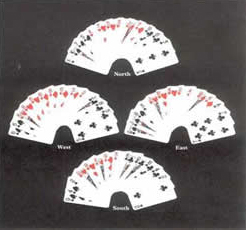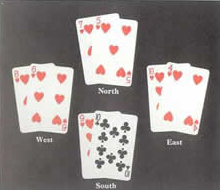Pokerwebpages.com → Games of Playing cards
The Dummy-Hand in Turn
Whist- Whist developed out of the of triumph. At first its practice was confined to the lower classes, but in 1718 it was taken up by a party of gentlemen, Lord Folkston among them, who met at the famous Crown Coffee House, and they, with the help of Edmond Hoyle, introduced the game to fashionable society. At this time the game was known as whisk: soon after it was changed to whist in order to underline the silence in which it was proper to play the game.
During the eighteenth centuries it was by far the most popular card game of the English speaking nations, but at the close of the nineteenth-century it lost much of its popularity due to the introduction of bridge. It is, however, still extensively played.
In principle whist is a very simple game, played by four players, two playing in partnership against the other two. The partners sit facing each other. Thirteen cards are dealt singly to each person, and the dealer exposes the last card to denote the trump suit. He takes it into his hand after he has played to the first trick.
The player on the left of the dealer leads to the first trick. Thereafter the player who wins a trick leads to the next. A player must follow suit to The card lead if he can, if not he may either discard or trump.
The object of the game is to win a rubber (best out of three games), and a game is won when one side has won 5 points. The first six tricks (the book) do not count for scoring: a side scores 1 point for each trick that it wins over six. The Ace, King, Queen and Jack of the trump suit are known as honors, and any side that is dealt all four of them scores 4 points, and any three 2 points. If, however, at the beginning of a deal a side has a score of 4 points it cannot score for honours.
The deal passes in a clockwise rotation.
Skill at whist is largely a matter of playing in close collaboration with one’s partner, and estimating from the cards held and those that have been played, the most likely position of those that remain to be played.
To this end, there are a number of recognized plays which should be departed from only under special circumstances, to be learnt by experience. It is, for example, good tactics for second player to play low and third high; a player should not finesse against his partner; and if an opponent plays an honour it is usually profitable to play a higher honour on it.
A player who holds five or more trumps in his hand should make it a rule to lead one; and if a player fails to lead a trump and wishes his partner to do so, he calls for the lead of one by first playing an unnecessarily high card in a suit and following it with a low card in the same suit.
The lead is a good opportunity for a player to give his partner information about his hand, and the leads listed in the table on page are standard practice and should be known all players. A pope joan board now in the Cheltenham Art Gallery and Museum . PLATE 17 (opposite, below) A game of fan tan in progress.
Holding |
1st Lead |
2nd |
A K Q J |
K |
J |
A K Q |
K |
Q |
A K X and more |
K |
A |
A K |
A |
K |
K Q J x |
K |
J |
K Q J xx |
J |
K |
K Q J xxx and more |
J |
Q |
A xxx and more |
A |
4th best of remainder |
K Q x and more |
K |
4th best of remainder |
A Q J |
A |
Q |
A Q J x |
A |
Q |
A Q J xx more |
A |
J |
K J 10 9 |
9 |
K (if A or Q falls) |
Q J x |
Q |
|
Q J xx and more |
4th best |
|
In the trump suit:
Holding |
1st Lead |
2nd |
A K Q J |
J |
Q |
A K Q |
Q |
K |
A K xxxxx and more |
K |
A |
A K xxxx |
4th best |
K |
In the deal below the mechanics of the game are illustrated.

South deals and turns up the 4 of Spades to denote trumps. West leads the 5 of Diamonds, and the play is:
| West | North | East | South |
| 5 | J | A | 3 |
West leads the fourth highest of his longest suit, commonly called fourth-best. East wins with the A . It would be finessing against his partner if he played the Q . In the event it makes no difference, because East has no better play than to return his partner’s suit, and it is proper to lead the highest from an original holding of three.
| 2 | 7 | Q | K |
South, therefore, wins the second trick, instead of the first, with the K .
| 5♣ | 3♣ | A♣ | K♣ |
| 8♣ | 6♣ | 7♣ | Q♣ |
East has no better lead than the 7♣. He knows that South holds the Q♣, because without it South would not have led the K♣ at the previous trick, but it offers a chance of trumping if West can take the lead early in the play.
| 10 | 5♠ | 4 | 9 |
| 6♠ | A♠ | 3♠ | 2♠ |
| 10♠ | K♠ | 8♠ | 4♠ |
| J♣ | 9♣ | 2♥ | 2♣ |
North has no better lead than the 9♣.
| West | North | East | South |
| 8 | 3♥ | J♠ | 4♣ |
| 6 | 7♠ | Q♠ | 9♠ |
East pulls the remaining trumps.
| K♥ | A♥ | J♥ | Q♥ |
The end position has come down to:

It is North lead. North and South have won six tricks, East and West five tricks. North, therefore, leads the 5♥. If East wins with the 10♥ his side will win the odd trick as West will win the last trick with the 8♥. North’s only hope is that East will make the mistake of playing the 4♥, because then south will win with the 9♥ and the last trick with the 10♣.
| 6♥ | 5♥ | 10♥ | 9♥ |
East makes no mistake.
| 8♥ | 7♥ | 4♥ | 10♣ |
East and West, therefore, have won the odd trick and score 1 point. There is no score for honours as both sides held two.
